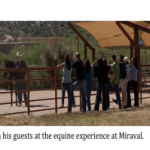To be an extraordinary leader: is it about the horse?
Fri, Apr 3, 2015
Coaching, Culture, Entrepreneur, entrepreneurship, Leadership Development, Supervision (managing direct reports)
Lessons from the Webb
- The Equine Experience (created by Wyatt Webb, Therapist)
At the wonderful Miraval Resort near Tucson, you can go to the stables and attempt to work with a horse (under the care of an expert). Try to get the horse to give you his hoof to clean. Sounds simple, right? You approach the horse, as instructed you reach down and pinch his leg, ready to hold it up and clean it with the pick in your other hand. Then nothing happens. The horse just stands there. You wonder: is the horse being stubborn?
You may have stated your intent to the horse – did he not hear you?
The wrangler then asks you a series of questions about your own behavior and underlying emotions. Were you tentative? Confused or uncertain? Worried? Fearful? If yes, the horse sensed it; and interpreted what he sensed as not a clear, strong command.
Or the horse may have picked up his hoof for a split second only to put it down almost instantly. Did you fail to support the hoof sufficiently, holding it firmly and high enough? Then the horse did not feel safe (on three legs) from falling down or needing to run away in case of predator and did not trust you.
When you did succeed, did someone try to take your picture? Did you look away at the camera for a moment? If you did, the horse put his hoof down though you were holding it. Horses do not accept multi-tasking. To risk their safety with you, they cannot afford anything but complete attention.
- And again
Now you are told to walk the horse around the circle holding the rope in your hands. Oops. You begin to walk and the horse stands still. Or you get him started but cannot get him to turn left or right. Or you want him to stop and he keeps walking. Or you walk and he stops.
Is it his training? His attitude on this day? Or did the horse not sense you looking in your intended direction, not see you walk before he felt the rope puling him? Or worse, did you really think you could lean against a 1200 pound animal to get him to turn?
And when you did not get what you want in either (1) or (2) above, what did your frustration lead you to do? Hopefully it was to try something different (the hind hoof first with a different approach?).
- Minimalist Learning
Whether you are the CEO wanting something from your Board, an alliance, or a key executive, the lessons should be clear. The horse worries about his safety and whether he should trust and respect you. He will do as you ask if you are clear in your intent and provide the support he needs to comply; if you signal where you want to go ahead of time, he will more likely buy in. The same lessons apply to the C-suite executive who wants something from the boss. And possibly in other relationships though I won’t speculate.
In the spirit of full disclosure, once in awhile the horse will not do the task even for the wrangler. And it may be about the horse or about the wrangler at that moment. And you should know that horses understand neither language nor voice-tone and are completely kinetic (physical) in their reading of you. Each human being has a dominant mode of taking information in: visual, auditory and kinetic. It helps to adapt.
If this story has you intrigued, then read the sequel, which I will publish in a week. It will have the full exposition of the take-aways from this vivid and somewhat surprising experience and a running conversation with the wrangler/therapist.
Wyatt Webb’s books are available on amazon:
That’s just my view. What’s yours?
If you like this post, share it with others. If you do not or disagree with parts of it, then tell me (leave a comment).
Tags: communication, getting what you want, Leadership, self-awareness, supervision

 Countless more ordinary people of equal talent never developed the leadership core required to run the show. Why not?
Countless more ordinary people of equal talent never developed the leadership core required to run the show. Why not?

One Response to “To be an extraordinary leader: is it about the horse?”